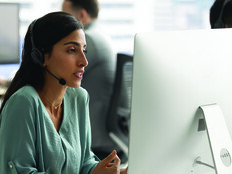Key Takeaways from OPM’s Remote Work Guidance
A vital message from the OPM memo: Agencies that are proactive when designing remote and telework positions are likely to get the most out of their workforce, and developing the tech tools and solutions for those workspaces is an essential task.
Managing the people in these jobs can be trickier without seeing them daily, but the technology is there to assist management and staff in improving their performance.
“AI is growing as an important element of the employee experience,” says Todd Gustafson, president of HP Federal and head of U.S. public sector at HP. “And it’s going to get better using optimized workflows to shift how we do our jobs.”
The memo brings a focus to how management can evaluate remote employee performance, and part of the answer involves using predictive analytics to ensure the employee’s technology is working to prevent downtime.
“Picture an employee’s laptop starting to fail, and it sends a message to management and IT personnel,” Gustafson says. “They authorize a replacement shipped to that remote employee before the laptop dies, and it’s preloaded with everything the employee needs.”
The Benefits of Re-Evaluating Remote Work Tech
As part of the evaluation process for deciding the remote or telework possibilities for particular jobs, an examination of available technology is necessary. There may be a position that would seem ideal for a hybrid work schedule but, because it requires a specific software solution available only in the office, that employee may have to stay put.
There should also be reassessments of the current technology used to see if it still adds to the productivity, collaboration and security of the hybrid workforce or if it should be replaced. Some key benefits of this include:
- Optimized tools and software: Updates and enhanced software may include features that achieve better productivity and streamlined workflows. A regular software check also ensures that solutions are more reliable and reduces susceptibility to delays and downtime.
- Better security: As cyberdefenses improve, cybercriminals modify their tactics to find other avenues to get inside government systems and wreak havoc, and a distributed workforce doesn’t help. People working from home for long periods “may not be as vigilant and alert about phishing attempts and other types of attacks as they would be in an office environment,” says Christine Halvorsen, public sector CTO for identity and access management firm Okta. “Evaluating security tools and procedures probably needs to be done more often than other areas because of the grave consequences of a cyberattack.”
- Cost savings: A regular software check can find program redundancies; for example, a software update that includes features that duplicate those of another system. It can also find underused subscriptions to help make decisions about where to spend resources.
- Better collaboration and communication: Without seamless communication between management and its distributed workforce, the ability to connect and develop shared goals and expectations is hindered. You may find the communication platforms you’ve been using haven’t kept up with the needs of your workforce. Or, conversely, remote employees may not have optimized their use of features such as file sharing or project management (for which the answer may be more training).
Key Technologies to Support a Remote and Hybrid Workforce
Employees spread across multiple regions and time zones need hardware and software tools, such as time zone scheduling solutions and easy cloud file access, to enhance their ability to collaborate.
Essential hardware for remote and telework varies depending on the job requirements, but a sturdy laptop, headset and multifunction printer are necessary. Dual or ultrawide monitors are often needed when doing project management, and virtual private networks may be required for working with sensitive information.
Besides the customary security, communication and collaboration packages, time tracking solutions keep teams focused on project and departmental goals. Programs such as remote desktop tools and those that measure employee engagement can assist management in making regular performance evaluations.
How Remote Work Tech Boosts Recruitment
In today’s tight labor market, many candidates see hybrid work schedules as a requirement because they’ve worked remotely in some form since 2020. To compete with the private sector, agencies need to offer the right tech tools that can smooth the employee experience.
Being able to quickly provision a remote or teleworking staffer with the hardware and software they need helps show the agency’s commitment.
Click the banner below to view the IT professionals who had the biggest impact on government in 2024.
“Provisioning used to take a day or more, getting people their laptop and loading the software and other tools they needed for their job,” says John Gordon, president and general manager of HP Managed Solutions. “Now, the computer is relying on as-a-service software in the cloud, and the laptop is virtually ready when you open it up.”
Another factor that can lead to better employees is a commitment to virtual continuing education and professional development. These online programs can be accessed at a time of the individual’s choosing, giving them the flexibility to take a personalized learning path and helping them stay up to date on the latest issues and practices in their field.
Once they’re on board, there are many employee engagement programs that boost job satisfaction and performance. New solutions using artificial intelligence tools can engage employees and keep them from feeling isolated from their team, no matter where they’re located.















